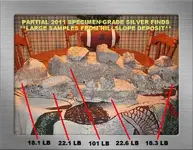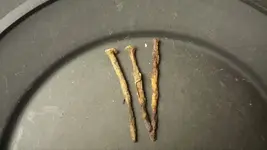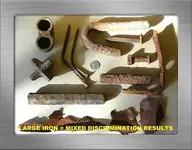Aufisher… a few more comments after thinking about this thread for awhile.
It seems to me that I’ve spent a disproportionate amount of time over the years testing how metal detectors and coil combinations react to variable iron shapes and sizes, and to variable iron mineralizations encountered while metal detecting in different areas across the country. In either form, my initial reaction is that iron is the bane of metal detecting for precious metals. But that is not an entirely complete picture. Iron does have some redeeming attributes or uses, aside from historical significance to relic collectors.
We all realize that over time iron corrodes, forming a rust halo that changes or enhances iron signals such that their target ID can and does differ from what can be expected from benchtested iron, or freshly buried iron targets in a backyard testplot. So from a practical standpoint, mining camp iron trash at variable depths is ideal to test and evaluate detector / coil combinations over real-world ground conditions and mineralizations for meaningful results.
Second, I think that iron-infested areas in prime silver hunting country here in Ontario are a blessing because proliferate iron signals effectively conceal valuable silver ores. Without the iron junk, readily accessible mining camps would soon be stripped of detectable near-surface silver.
And third, in our heavily forested outback, patches of iron trash alert you to sites of past activity that might otherwise be overlooked…sites long since obscured by encroaching forest cover. But there’s no mistaking abundant iron signals. These are a tip-off to search for relics and bottles…particularly bottles on the downside of the nearest hillslope. It was such a scenario that led me to a deposit of large silver in the outback a few years ago… handsome silver that might otherwise not have been found. That's it... just a few thoughts to chew on...
Jim.







